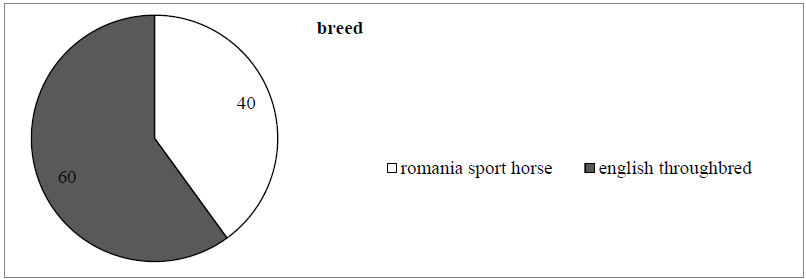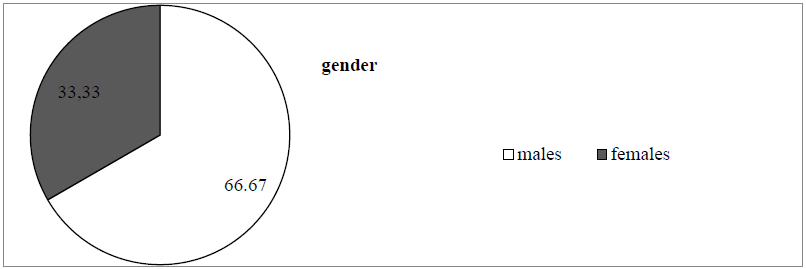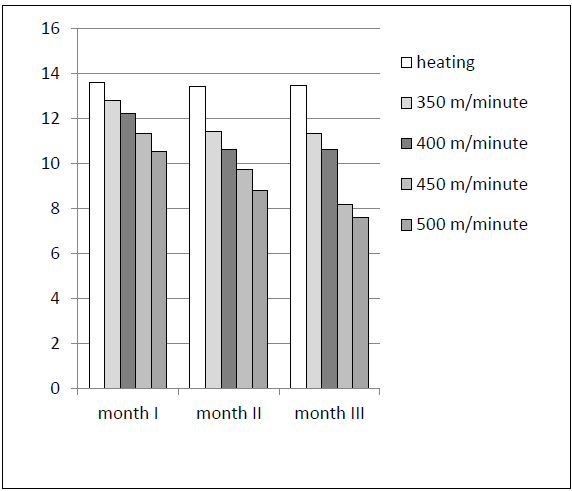Blood Oxygen Dynamic, during the Effort Test in Conjunction with the New Technologies for Sports Horse Training
Abstract
The purpose of this study was to reveal the oxygen blood content in horses, due to training for sport performances, in order to sustain the importance of equestrian sports for multidimensional education, as a interdisciplinary combination of veterinary medicine and sport. The quantity of circulating red cells and haemoglobin, carried by the arterial blood, influences favourably the amount of circulated oxygen. Ensuring a higher aerobic capacity in horses used in equestrian sports, by increasing the oxygen transport capacity, associated with erythrocytes realising through splechnocontraction, is a factor of prime importance. The present work aim at measuring the values of arterial oxygen in the effort test, during the different periods of training. Increasing the speed determine a decrease in the partial pressure of O2 no matter which month was assessed, the most important being in heating in the third month (13,46±0,05 KP), while the lowest was also in the third month at 500 m/minute speed (7,59±0,04 KP), most differences being highly significant. It can be noted a decrease in pO2 value, which is less important compared to the second month of training. Understanding the influence and interaction of factors dependent or independent of the animal body, in conditions of health security for sport horses, go to the application of innovative methods of training appropriate to obtain athletic performance. On international level the importance of this topic is seen in the necessity of knowing the dynamic of oxygen levels. These researches lead to obtain horse performances but also to avoid illness situation.
Keywords: Bloodefforthorseoxygensport
Introduction
Hipic sport is seen by some authors as a science or an art, but the most horse lovers consider the
hipic sport as something more complex and complete, based on deep communication between horses
and humans.
Hipic sports or ridding art is helping to physical development of the riders, maintaining their health
and also to create good and moral features (courage, skills, optimism, and patience).
In horses used in equestrian sports, the adaptability to effort and high performances is an
indispensable requirement.
Muscle in labour requires oxygen which is ensured by the functioning of ATP metabolic pathways.
The sanguine oxygen is reached into the lungs along with the air and is used in aerobic processes
which are taking place in mitochondria.
Muscle activity, activated by muscle labouring, is supplied with oxygen which was coupled with
haemoglobin and transported through the blood vessels. Heart activity during training is regulated
depending on the effort intensity and length.
Cardiovascular adjustments that occur in the increasing transport capacity and oxygen intake during
muscle labour in horses used in equestrian sports are:
1.Increasing the cardiac output by means of the increasing heart rate;
2.Intensifying blood activity towards active areas;
3.Increasing blood oxygen transport capacity;
4.Economical use of oxygen at muscle level.
The resemblance between human beings and horses is the increasing cardiac output during effort,
which is possible by increasing the cardiac frequency and systolic ejection volume.
In muscular effort made by horses used in hipic sports becomes hypoxemic in efforts with intensity
higher than 65% from maximum oxygen volume (Amory, Art &Lekeux, 1989; Corouce, 2000; Evans
& Rose, 1988; Georgescu et. al., 1971).
Hypoxemia is due to the high level of muscle aerobic capacity and also to respiratory
diseases(Amory, Art &Lekeux, 1989; Beech, 1991).
In sport horses, highly developed aerobic capacity of skeletal muscle is a limiting factor of
performance, seemingly paradoxical.
Materials and methods
For biochemical and physiological measurements the biological material was represented by a total
livestock of 15 sport horses.
There were studied both females and males, aged 5 to 10 years old and over 10 years old,
specialized and well trained for Eventing horse trials.
The used breeds were Romanian Sport horse and English thoroughbred (Table




Blood harvesting was made immediately after effort in Li-heparin tubes.
Plasma was separated by centrifugation and put in different tubes, immersed in cold water with ice
and maintained in isotherm bags, at maximum 4 ºC. Plasmatic lactate dosing was done within 30
minutes after collection.
This test was repeated for 3 times, at heating period, and after exercise, at various speeds, while the
horses were gradually trained.
There were analysed for each period, a total of 75 samples, 15 samples in heating, 15 samples at 350
m/minute, 15 samples at 400 m/minute, 15 samples at 450 m/minute and 15 samples at 500 m/minute,
in total 215 samples being analysed for all 3 periods.
For standardized effort test under field conditions, horses were put to the following levels of effort
(Couroucé, 2000).
-Heating to small trot – 5 minutes;
-Level II – 3 minutes in gallop at speed 350 m/minutes;
-Level III – 3 minutes in gallop at speed 400 m/minutes;
-Level IV – 3 minutes in gallop at speed 450 m/minutes;
-Level V – 3 minutes in gallop at speed 500 m/minutes;
-Pause between levels – 1 minute;
-Active recovery to small trot – 5 minutes
In order to eliminate the possible errors, the land that was used in the test was the same used during
horse training.
The horse riders were also the same persons who trained the horses.
Arterial blood samples were sampled before exercise and at the end of each effort level, from
transverse facial artery, using a catheter with 20 G diameter and 32 mm length (Georgescu et al., 1971).
This operation was carried on as follows:
-identifying the artery found in the zigomatic left region, by palpation;
-local disinfection with alcohol and superficial dermal anaesthesia above the artery with 0,2 ml
lidocaine 2%. Exceeding this amount may lead to facial nerve anaesthesia with possible facial
paralysis and therefore is not recommended.
-after 3-5 minutes the artery is cannulated, advancing 3-4 mm into the vessel lumen, tan the
needle is withdrawn partially to maintain the rigidity of the cannula. The cannula will be pushed
slightly forward to the end and the needle will withdraw within its total;
-injection of 0,2 ml saline solution 0,9 % with heparin (4 I.U/ml saline solution) in the cannula,
followed by quick application of the cannula cap. This will prevents blood clotting within the
cannula
-bounding the two wings of the cannula to the skin with special adhesive and securing the
cannula position by application of additional adhesive tape.
Arterial blood collection was carried out in syringes of 2 ml heparin, airtight, avoiding contact with
air. Blood samples were stored on ice flask at 0-4 ºC.
Transportation to the laboratory was made during about one hour.
By means of blood samples there were determined the oxygen levels. In order to determine the
blood gases there was used a gas analyser – AVL 995-S-type.
Results and discussions


Arterial partial pressure of O2 in the first month, gradually decreases with the increasing speed, from the heating average value of 13,6 KP to an average of 10,53 KP to the last level of speed (500 m/minute). The same dramatic decrease in pO2 is also found in the second month, from 13,42 KP at heating level to 8,82 KP al last level. In the third month of training, pO2 kept the same decreasing line, from 13,46 KP when heating, to 7,59 KP to the last level. Comparing the average values of pO2 in the three month of training, it can be seen that although the average values with heating are about the same after completing the four levels of effort, pO2 decreases in all periods mainly in the third month, where the value reached an average of 7,59 KP.
Statistical calculations are presented in table
Statistical calculations for pO2 indicate in the heating period insignificant differences between the first and third month and second and third month and significant differences between the first and second month (Table
At 350 m/minute and 400m/minute speeds, the differences were very significant, except for the differences between the first and the third month, for both speeds, where the differences were insignificant (Table
Performances achievements as well for human beings as for animals are undoubtedly linked to O2blood amounts which allow the physical effort process. The balance between maximum performance and health status represents the basic aim of sports medicine because subliminal physical effort may be considered a significant stressing agent able to induce the disease status. This is the main reason on account of which, both in human sports medicine as in sports skills breeds medicine (horse, camel,
dog), one has tried the scientific rationalization of training and physical activity methods.
The approach of this topic is requested by the necessity of identifying some objective and practical
assessment ways for the sports horse , which will help to a precise dimensioning of trainings length and
intensity but also for the assessment of their effects upon the physical training level.
The awareness of these physiological and biochemical processes will certainly lead to the
improvement of the effort capacity and consequently to performances achievement.
Understanding the influence and interaction of factors dependent or independent of the animal body,
in conditions of health security for sport horses, go to the application of innovative methods of training
appropriate to obtain athletic performance.
Conclusions
The carried out analyses shoes that the chemical energy output, so necessary for the physical effort
of horses used in equestrian sports, is produced via aerobic metabolism, mechanism which has the
highest yield.
Production of chemical energy through aerobic path metabolism, required by physical effort with
horses used in hipic sports, is a lucrative biochemical mechanism.
The efficiency is in a strong relationship with the glucose oxidation yield and AGL in relation to
anaerobic glycolysis.
Secondary products activity of aerobic metabolism (CO2 and H2O) has less negative influences than the ones resulting from anaerobic metabolism (lactic acid).
For very high yield during training, increasing the oxidative capacity of skeletal muscle, to horses used in equestrian sports, is one of the main objectives in order to obtain high performances.
These transformations have been demonstrated by several authors (Courouce, 2000; Georgescu et. al, 1971; Beech, 1991). Along with these oxidative increases during exercises, it is required concentration measurements of arterial blood gases (O2, CO2), measurements that help determining directly of anaerobic capacity and indirect by aerobic capacity.
This is closely related to higher energy yield of glucose oxidation versus anaerobic glycolysis. Following the results obtained from test it is obvious that the training affect significantly the arterial blood concentrations of O2, CO2 and pH values.
Increasing the speed determine a decrease in the partial pressure of O2, no matter which month was assessed. The most important decrease was in heating in the third month, while the lowest was also in the third month but at 500 m/minute speed, and most differences being highly significant. It can be noted a decrease in pO2, value, which is less important compared to the second month of training, with reference to the first month of training. In the third month of training pO2 values have maintained the same trend.
Availability of a higher aerobic capacity provided by training, leads to more important decrease in arterial blood pO2 with horses in the first month of training, compared to the other month of training.
This is explained by the increasing the O2, uptake of the muscle during activity
References
- Amory, H., Art, T., Lekeux, P. (1989). Adaptation cardio respiratoire et thermoregulatrice a l’effort et a l’entrainement dans l’espece equine. Clinique de cheval, Horse Club. Cureghem: Ed par Office de course.
- Courouce, A. (2000). Epreuves d’effort de terrain et applications pratiques. Prat. Vet.Equine, 32, 87-94. Evans, D.L., Rose, R.J. (1988). Cardiovascular and respiratory responses to submaximal exercise training in the thoroughbred horse. Pflugers Arch. 411(3), 316-321.
- Georgescu, Gh., Marinescu, M., Stoica, A., Curelariu, N., Căprărin, A., & Cazacu, O. (1971). Cercetări asupra unor constant biochimice şi corelaţia lor cu aptitudinea de viteză la calul Trăpaş românesc. Redacţia revistelor agricole, Lucr. şt., seria D(XIV), 241-247.
- Beech, J. (1991).Equine respiratory disorders.Philadelphia, London: Ed. Lea & Febiger.
Copyright information

This work is licensed under a Creative Commons Attribution-NonCommercial-NoDerivatives 4.0 International License.
About this article
Publication Date
04 October 2016
Article Doi
eBook ISBN
978-1-80296-014-3
Publisher
Future Academy
Volume
15
Print ISBN (optional)
-
Edition Number
1st Edition
Pages
1-1115
Subjects
Communication, communication studies, social interaction, moral purpose of education, social purpose of education
Cite this article as:
Şovarel, E. (2016). Blood Oxygen Dynamic, during the Effort Test in Conjunction with the New Technologies for Sports Horse Training. In A. Sandu, T. Ciulei, & A. Frunza (Eds.), Logos Universality Mentality Education Novelty, vol 15. European Proceedings of Social and Behavioural Sciences (pp. 891-898). Future Academy. https://doi.org/10.15405/epsbs.2016.09.111

